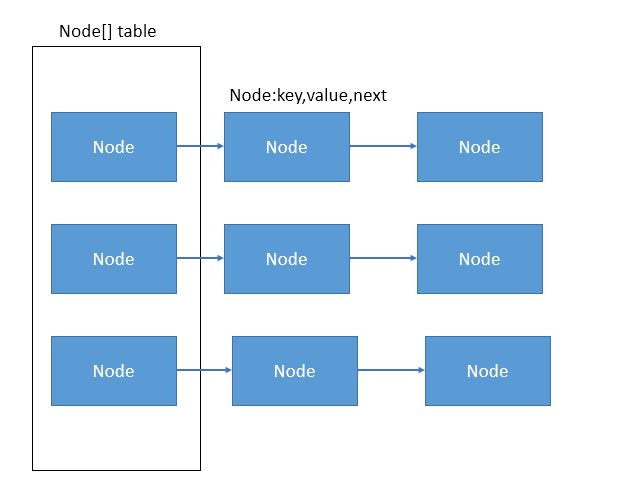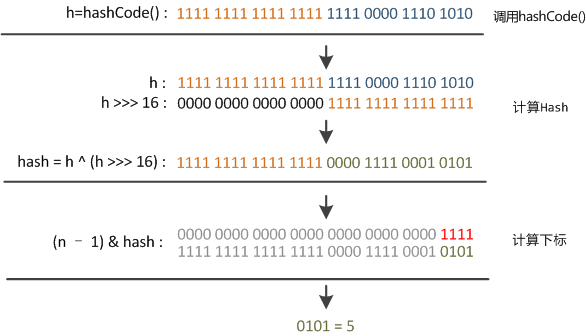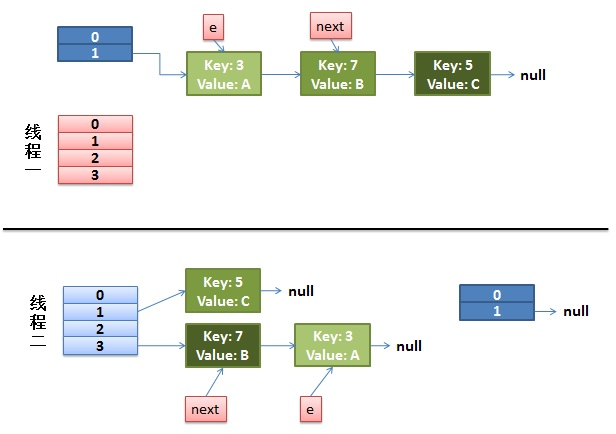HashMap源码学习
HashMap实现了Map接口,继承自AbstractMap,并且是LinkedHashMap的父类。
JDK8中的HashMap
在jdk8中,HashMap的底层的存储结构是一个Node对象的数组,也叫哈希桶,每个桶放的是链表,链表中的元素,就是HashMap中的元素。

涉及到扩容,关于扩容的参数有:
- initialCapacity(初始容量),loadFactor(负载因子),threshold(阈值,等于数组的长度乘以loadFactor
JDK8中,当链表长度达到8时,会转化成红黑树。
1.链表节点Node
与JDK1.7中的HashMap不同,1.8中的链表节点类名是Node.
static class Node<K,V> implements Map.Entry<K,V> {
final int hash; //哈希值
final K key;//key
V value;//value
Node<K,V> next; //后置节点
Node(int hash, K key, V value, Node<K,V> next) {
this.hash = hash;
this.key = key;
this.value = value;
this.next = next;
}
public final K getKey() { return key; }
public final V getValue() { return value; }
public final String toString() { return key + "=" + value; }
//每个节点的hashcode是由key的hashcode和value的hashcode进行异或得到的。
public final int hashCode() {
return Objects.hashCode(key) ^ Objects.hashCode(value);
}
public final V setValue(V newValue) {
V oldValue = value;
value = newValue;
return oldValue;
}
public final boolean equals(Object o) {
if (o == this)
return true;
if (o instanceof Map.Entry) {
Map.Entry<?,?> e = (Map.Entry<?,?>)o;
if (Objects.equals(key, e.getKey()) &&
Objects.equals(value, e.getValue()))
return true;
}
return false;
}
}
2.构造方法
在构造方法中,无论传入的初始容量是多少,HashMap都会通过位运算计算出最接近的2的n次幂的值,从而构造一个2的n次幂的桶
//默认的初始capacity static final int DEFAULT_INITIAL_CAPACITY = 1 << 4; // aka 16 //最大capacity static final int MAXIMUM_CAPACITY = 1 << 30; //默认的load factor static final float DEFAULT_LOAD_FACTOR = 0.75f; //存储Node节点的数组 transient Node<K,V>[] table;
//HashMap中元素数量的阈值,当元素数量超过阈值时,就会发生扩容 int threshold; //负载因子,用于计算HashMap元素数量的阈值,threshold=table.length * loadFactor final float loadFactor;
//初始化一个指定初始化capacity和loadfactor的HashMap
public HashMap(int initialCapacity, float loadFactor) {
//边界检查,capacity不能为负数
if (initialCapacity < 0)
throw new IllegalArgumentException("Illegal initial capacity: " +
initialCapacity);
//如果超过最大的capacity,设置为capacity
if (initialCapacity > MAXIMUM_CAPACITY)
initialCapacity = MAXIMUM_CAPACITY;
if (loadFactor <= 0 || Float.isNaN(loadFactor))
throw new IllegalArgumentException("Illegal load factor: " +
loadFactor);
this.loadFactor = loadFactor;
//threshold由initialCapacity计算得来
this.threshold = tableSizeFor(initialCapacity);
}
/**
* 根据期望容量cap返回2的n次方的哈希桶的实际容量,返回值一般大于等于cap
*/
static final int tableSizeFor(int cap) { //假设cap=3
int n = cap - 1;//n=2,二进制写法是00000010
n |= n >>> 1;//先右移一位是00000001,或的结果是00000011
n |= n >>> 2;
n |= n >>> 4;
n |= n >>> 8;
n |= n >>> 16;
//最终n=3,最后返回n+1
return (n < 0) ? 1 : (n >= MAXIMUM_CAPACITY) ? MAXIMUM_CAPACITY : n + 1;
}public HashMap(int initialCapacity) {
this(initialCapacity, DEFAULT_LOAD_FACTOR);
}
public HashMap() {
this.loadFactor = DEFAULT_LOAD_FACTOR;
}
//初始化一个HashMap,将另一个map的元素放入这个HashMap中。
public HashMap(Map<? extends K, ? extends V> m) {
this.loadFactor = DEFAULT_LOAD_FACTOR;
putMapEntries(m, false);
}
//将另一个map的所有元素加入表中,参数evict初始化时为false,其他情况为true
final void putMapEntries(Map<? extends K, ? extends V> m, boolean evict) {
//先获取map的大小
int s = m.size();
//如果大于0
if (s > 0) {
//如果table此时为null
if (table == null) { // pre-size
//根据m的元素数量和负载因子计算出阈值
float ft = ((float)s / loadFactor) + 1.0F;
//不能超过最大capacity
int t = ((ft < (float)MAXIMUM_CAPACITY) ?
(int)ft : MAXIMUM_CAPACITY);
//如果t大于当前的阈值,返回一个新的满足2的n次方的阈值
if (t > threshold)
threshold = tableSizeFor(t);
}
//如果此时table不为空且m的元素数量大于threshold
else if (s > threshold)
resize();//扩容,以便容纳m的所有元素,有可能出现扩容以后还是无法容纳所有元素,但因为putVal方法里面会扩容。
//遍历m依次将元素放入HashMap中
for (Map.Entry<? extends K, ? extends V> e : m.entrySet()) {
K key = e.getKey();
V value = e.getValue();
putVal(hash(key), key, value, false, evict);
}
}
}
3.hash()方法
static final int hash(Object key) {
int h;
return (key == null) ? 0 : (h = key.hashCode()) ^ (h >>> 16);
}
h>>>16刚好是获取了高位部分,最后是hashcode的低位和高位做异或,增加低位的随机性。

3.扩容函数
扩容函数用于初始化或者扩大哈希桶的大小为原来的两倍,返回扩容后的Node数组。
如果当前哈希桶为空,分配符合当前阈值的初始容量目标,如果不为空就扩容为原来的两倍。
final Node<K,V>[] resize() {
//oldTab为当前哈希桶
Node<K,V>[] oldTab = table;
//oldCap为当前哈希桶的容量
int oldCap = (oldTab == null) ? 0 : oldTab.length;
//oldThr为当前的阈值
int oldThr = threshold;
//初始化newCap和newThr为0
int newCap, newThr = 0;
//如果当前哈希桶容量大于0
if (oldCap > 0) {
//如果当前哈希桶容量大于等于最大容量,就只好随你碰撞了
if (oldCap >= MAXIMUM_CAPACITY) {
//阈值为int类型的最大值
threshold = Integer.MAX_VALUE;
//返回当前哈希桶,不再扩容
return oldTab;
}
//newCap等于当前哈希桶容量的两倍,如果这个值小于最大容量,且当前哈希桶容量大于等于默认初始容量
else if ((newCap = oldCap << 1) < MAXIMUM_CAPACITY &&
oldCap >= DEFAULT_INITIAL_CAPACITY)
//则新的阈值等于当前阈值的两倍
newThr = oldThr << 1; // double threshold
}
//如果当前哈希桶为空,但是有阈值,代表是初始化时指定了容量阈值的情况
else if (oldThr > 0) // initial capacity was placed in threshold
newCap = oldThr;//则新的容量等于当前阈值
else { // 如果当前哈希桶为空,且阈值也为0
newCap = DEFAULT_INITIAL_CAPACITY;//新的容量为默认初始容量
//新的阈值等于默认负载因子乘以默认初始容量
newThr = (int)(DEFAULT_LOAD_FACTOR * DEFAULT_INITIAL_CAPACITY);
}
if (newThr == 0) {//如果新的阈值时0,即当前表是空的,但是有阈值,此时newCap等于当前阈值
float ft = (float)newCap * loadFactor;//根据新表容量和负载因子求出新的阈值,这样的话新表的容量就大于新的阈值了
newThr = (newCap < MAXIMUM_CAPACITY && ft < (float)MAXIMUM_CAPACITY ?
(int)ft : Integer.MAX_VALUE);
}
//更新阈值
threshold = newThr;
@SuppressWarnings({"rawtypes","unchecked"})
Node<K,V>[] newTab = (Node<K,V>[])new Node[newCap];
//更新table
table = newTab;
if (oldTab != null) {
//当当前的table数组不为空时,重新分配数组中的数据。
for (int j = 0; j < oldCap; ++j) {
Node<K,V> e;
if ((e = oldTab[j]) != null) {
//将原链表置空,以便GC
oldTab[j] = null;
//如果当前节点没有后续节点,直接赋值
if (e.next == null)
newTab[e.hash & (newCap - 1)] = e;
else if (e instanceof TreeNode)
((TreeNode<K,V>)e).split(this, newTab, j, oldCap);
else { // 如果当前节点有后续节点,则要进行重新分配
Node<K,V> loHead = null, loTail = null;
Node<K,V> hiHead = null, hiTail = null;
Node<K,V> next;
do {
next = e.next;
//留在原位置的节点
if ((e.hash & oldCap) == 0) {
if (loTail == null)
loHead = e;
else
loTail.next = e;
loTail = e;
}
//移动到原位置+oldCap的节点
else {
if (hiTail == null)
hiHead = e;
else
hiTail.next = e;
hiTail = e;
}
} while ((e = next) != null);
if (loTail != null) {
loTail.next = null;
newTab[j] = loHead;
}
if (hiTail != null) {
hiTail.next = null;
newTab[j + oldCap] = hiHead;
}
}
}
}
}
return newTab;
}
扩容后,由于哈希桶的长度变化,集合中的部分元素的位置也会发生变化。JDK8中采用了一个非常巧妙的计算方式,来判断哪些元素需要变动位置,哪些元素不需要。
下图表示扩容前key1和key2的hash值,以及key1和key2在哈希桶中的位置(为了方便画图只显示8个位,实际上有32个位),此时key1和key2在哈希桶的位置((n-1)&key)是相同的。

下图是扩容后key1和key2的hash值,此时可以发现,key1的位置并没有变动,而key2的位置发生了变动。

key2的原位置由5变为21,中间增加了16,而16恰好是原有的哈希桶大小00010000(在resize函数里就是局部变量oldCap)。
由此发现,位置是否移动,取决于key和新增的一位是1还是0,当key&oldCap等于0(也就是新增的一位为0,如00000101)时,位置不需要移动,当key&oldCap不等于0(新增的一位为1,如00010101),key在哈希桶中的索引为原位置+oldCap。
JDK8这样优化的好处是,省去了重新计算hash值的时间,由于新增的一位是0还是1是随机的,所以这样一来,就将原有冲突的元素均匀地分到新的位置了。
4.Put函数
//put方法实际上调用了putVal方法
public V put(K key, V value) {
return putVal(hash(key), key, value, false, true);
}
final V putVal(int hash, K key, V value, boolean onlyIfAbsent,
boolean evict) {
Node<K,V>[] tab; Node<K,V> p; int n, i;
//如果table数组为空,则首先扩容,n为扩容后的长度
if ((tab = table) == null || (n = tab.length) == 0)
n = (tab = resize()).length;
//(n-1)&hash计算当前的key在数组中的位置,如果该位置上还没有结点,直接put
if ((p = tab[i = (n - 1) & hash]) == null)
tab[i] = newNode(hash, key, value, null);
//如果已经有结点了
else {
Node<K,V> e; K k;
//如果结点的key值与要插入的key值相同,直接覆盖
if (p.hash == hash &&
((k = p.key) == key || (key != null && key.equals(k))))
e = p;
//如果是红黑树
else if (p instanceof TreeNode)
e = ((TreeNode<K,V>)p).putTreeVal(this, tab, hash, key, value);
//否则就要遍历结点所在链表后,添加在链表的尾部,e此时为头结点
else {
for (int binCount = 0; ; ++binCount) {
//当找到链表的尾部时即下一个节点为空,在链表的尾部添加新的结点
if ((e = p.next) == null) {
p.next = newNode(hash, key, value, null);
//当链表的长度超过8,就调用treeifyBin函数
//当tab的大小超过64,就将链表转化为一棵红黑树,否则调用resize进行扩容
if (binCount >= TREEIFY_THRESHOLD - 1) // -1 for 1st
treeifyBin(tab, hash);
break;
}
//如果在遍历链表的时候发现有结点的key值与要插入的key值相同,退出循环
if (e.hash == hash &&
((k = e.key) == key || (key != null && key.equals(k))))
break;
p = e;
}
}
//当e不为null时,此时说明链表中存在要插入的key
if (e != null) { // existing mapping for key
V oldValue = e.value;
//当onlyIfAbsent为false,即在存在相同的key值时进行替换(如果为true则不替换)
if (!onlyIfAbsent || oldValue == null)
e.value = value;
afterNodeAccess(e);
//返回原有的值
return oldValue;
}
}
//modCount加1
++modCount;
if (++size > threshold) //检查是否超过阈值
resize();
afterNodeInsertion(evict);
return null; //因为原hashMap中key不存在,所有返回null
}
5.Get函数
public V get(Object key) {
Node<K,V> e;
return (e = getNode(hash(key), key)) == null ? null : e.value;
}
/**
* Implements Map.get and related methods
*
* @param hash hash for key
* @param key the key
* @return the node, or null if none
*/
final Node<K,V> getNode(int hash, Object key) {
Node<K,V>[] tab; Node<K,V> first, e; int n; K k;
//如果table数组不为空,并且对应位置的链表头结点不为空
if ((tab = table) != null && (n = tab.length) > 0 &&
(first = tab[(n - 1) & hash]) != null) {
//如果key与链表头结点相同,则返回链表头结点
if (first.hash == hash && // always check first node
((k = first.key) == key || (key != null && key.equals(k))))
return first;
//如果key与链表头结点不同,则遍历链表
if ((e = first.next) != null) {
if (first instanceof TreeNode)
return ((TreeNode<K,V>)first).getTreeNode(hash, key);
do {
if (e.hash == hash &&
((k = e.key) == key || (key != null && key.equals(k))))
return e;
} while ((e = e.next) != null);
}
}
return null;
}
6.Remove方法
/**
* Removes the mapping for the specified key from this map if present.
*
* @param key key whose mapping is to be removed from the map
* @return the previous value associated with <tt>key</tt>, or
* <tt>null</tt> if there was no mapping for <tt>key</tt>.
* (A <tt>null</tt> return can also indicate that the map
* previously associated <tt>null</tt> with <tt>key</tt>.)
*/
public V remove(Object key) {
Node<K,V> e;
return (e = removeNode(hash(key), key, null, false, true)) == null ?
null : e.value;
}
/**
* Implements Map.remove and related methods
*
* @param hash hash for key
* @param key the key
* @param value the value to match if matchValue, else ignored
* @param matchValue if true only remove if value is equal
* @param movable if false do not move other nodes while removing
* @return the node, or null if none
*/
final Node<K,V> removeNode(int hash, Object key, Object value,
boolean matchValue, boolean movable) {
Node<K,V>[] tab; Node<K,V> p; int n, index;
//如果table数组不为空,并且对应位置链表的头结点不为空
if ((tab = table) != null && (n = tab.length) > 0 &&
(p = tab[index = (n - 1) & hash]) != null) {
Node<K,V> node = null, e; K k; V v;
//如果要删除的key与链表头结点的key相同,则说明要删除的结点就是链表头结点
if (p.hash == hash &&
((k = p.key) == key || (key != null && key.equals(k))))
node = p;
//遍历以找到要删除的结点,以及要删除结点的上一个结点p
else if ((e = p.next) != null) {
if (p instanceof TreeNode)
node = ((TreeNode<K,V>)p).getTreeNode(hash, key);
else {
do {
if (e.hash == hash &&
((k = e.key) == key ||
(key != null && key.equals(k)))) {
node = e;
break;
}
p = e;
} while ((e = e.next) != null);
}
}
if (node != null && (!matchValue || (v = node.value) == value ||
(value != null && value.equals(v)))) {
if (node instanceof TreeNode)
((TreeNode<K,V>)node).removeTreeNode(this, tab, movable);
else if (node == p)//如果要删除的结点是链表的头结点
tab[index] = node.next;//将table数组对应位置赋值给其下一个结点
else
p.next = node.next;
++modCount;
--size;
afterNodeRemoval(node);
return node;
}
}
return null;
}
JDK7中的HashMap
一.链表节点Entry
jdk 1.7中用Entry作为链表节点类。
static class Entry<K,V> implements Map.Entry<K,V> {
final K key;
V value;
Entry<K,V> next;
int hash;
/**
* Creates new entry.
*/
Entry(int h, K k, V v, Entry<K,V> n) {
value = v;
next = n;
key = k;
hash = h;
}
public final K getKey() {
return key;
}
public final V getValue() {
return value;
}
public final V setValue(V newValue) {
V oldValue = value;
value = newValue;
return oldValue;
}
public final boolean equals(Object o) {
if (!(o instanceof Map.Entry))
return false;
Map.Entry e = (Map.Entry)o;
Object k1 = getKey();
Object k2 = e.getKey();
if (k1 == k2 || (k1 != null && k1.equals(k2))) {
Object v1 = getValue();
Object v2 = e.getValue();
if (v1 == v2 || (v1 != null && v1.equals(v2)))
return true;
}
return false;
}
public final int hashCode() {
return Objects.hashCode(getKey()) ^ Objects.hashCode(getValue());
}
public final String toString() {
return getKey() + "=" + getValue();
}
/**
* This method is invoked whenever the value in an entry is
* overwritten by an invocation of put(k,v) for a key k that's already
* in the HashMap.
*/
void recordAccess(HashMap<K,V> m) {
}
/**
* This method is invoked whenever the entry is
* removed from the table.
*/
void recordRemoval(HashMap<K,V> m) {
}
}
Entry是HashMap的内部类, 从成员变量可以看出
- key是HashMap中的key
- value是HashMap中的value
- next指向下一个链表节点
- hash表示hash值
二.Put方法
public V put(K key, V value) {
if (table == EMPTY_TABLE) {
inflateTable(threshold);
}
if (key == null)
return putForNullKey(value);
int hash = hash(key);
int i = indexFor(hash, table.length);
for (Entry<K,V> e = table[i]; e != null; e = e.next) {
Object k;
if (e.hash == hash && ((k = e.key) == key || key.equals(k))) {
V oldValue = e.value;
e.value = value;
e.recordAccess(this);
return oldValue;
}
}
modCount++;
addEntry(hash, key, value, i);
return null;
}
第一步,判断数组是否为空,是否需要初始化
第二步,如果key为null,则put一个空值进去
第三步,计算key的哈希值
第四步,根据哈希值定位到对应的桶,即在数组中的位置
第五步,遍历桶中的链表,看是否找到hashcode相等的、key相等的节点,如果有则覆盖原来的值,返回原来的值
第六步,如果找不到hashcode相等和key相等的节点,就将其添加到桶对应的链表的头部(从addEntry方法可以看出)
1)hash方法和indexFor方法
indexFor方法输入key的hash值和桶的大小,返回桶的位置。
/**
* Returns index for hash code h.
*/
static int indexFor(int h, int length) {
// assert Integer.bitCount(length) == 1 : "length must be a non-zero power of 2";
return h & (length-1);
}
indexFor方法返回桶的位置,因为length总是等于2的n次方,所以h&(length-1)时相当于对length取模(即h%length)。
因为HashMap中桶的大小为2的n次幂,所以与运算的结果是高位全部归零,低位作为index.例如此时桶大小为16,16-1=15,二进制表示0000000000000000000001111
1010010111000100001000101
& 0000000000000000000001111
---------------------------------------
0000000000000000000000101
得到的结果是截取了最后四位,如果只通过最后四位来决定散列的结果,容易导致碰撞,所以需要用hash函数来进行“扰动”。
所以HashMap中元素的哈希值不仅仅是key的hashcode而已,而是经过了一些位运算,增加低位的随机性,从而减少碰撞。
/**
* Retrieve object hash code and applies a supplemental hash function to the
* result hash, which defends against poor quality hash functions. This is
* critical because HashMap uses power-of-two length hash tables, that
* otherwise encounter collisions for hashCodes that do not differ
* in lower bits. Note: Null keys always map to hash 0, thus index 0.
*/
final int hash(Object k) {
int h = hashSeed;
if (0 != h && k instanceof String) {
return sun.misc.Hashing.stringHash32((String) k);
}
h ^= k.hashCode();
// This function ensures that hashCodes that differ only by
// constant multiples at each bit position have a bounded
// number of collisions (approximately 8 at default load factor).
h ^= (h >>> 20) ^ (h >>> 12);
return h ^ (h >>> 7) ^ (h >>> 4);
}
2)addEntry和createEntry方法
/**
* Adds a new entry with the specified key, value and hash code to
* the specified bucket. It is the responsibility of this
* method to resize the table if appropriate.
*
* Subclass overrides this to alter the behavior of put method.
*/
void addEntry(int hash, K key, V value, int bucketIndex) {
if ((size >= threshold) && (null != table[bucketIndex])) {
resize(2 * table.length);
hash = (null != key) ? hash(key) : 0;
bucketIndex = indexFor(hash, table.length);
}
createEntry(hash, key, value, bucketIndex);
}
void createEntry(int hash, K key, V value, int bucketIndex) {
//获取了桶中链表的头结点
Entry<K,V> e = table[bucketIndex];
table[bucketIndex] = new Entry<>(hash, key, value, e);
size++;
}
HashMap通过调用addEntry方法来添加一个Entry对象,hash表示hashcode,key/value不用说,bucketIndex是桶的位置即数组的索引。
1.如果容器大小超过了阈值并且桶不为空,则要扩容成原来的两倍,并且将当前的key重新hash重新定位得到新的bucketIndex'
2.最终都调用了createEntry方法,createEntry首先获取了桶中链表的头结点(有可能是null)
3.创建了一个新的Entry对象,并将Entry中的next指向原来的头结点,也就是说新的Entry成为了桶中链表的新的头结点。
三.扩容函数resize方法
void resize(int newCapacity) {
Entry[] oldTable = table;
int oldCapacity = oldTable.length;
if (oldCapacity == MAXIMUM_CAPACITY) {
threshold = Integer.MAX_VALUE;
return;
}
Entry[] newTable = new Entry[newCapacity];
transfer(newTable, initHashSeedAsNeeded(newCapacity));
table = newTable;
threshold = (int)Math.min(newCapacity * loadFactor, MAXIMUM_CAPACITY + 1);
}
/**
* Transfers all entries from current table to newTable.
*/
void transfer(Entry[] newTable, boolean rehash) {
int newCapacity = newTable.length;
for (Entry<K,V> e : table) {
while(null != e) {
Entry<K,V> next = e.next;
if (rehash) {
e.hash = null == e.key ? 0 : hash(e.key);
}
int i = indexFor(e.hash, newCapacity);
e.next = newTable[i];
newTable[i] = e;
e = next;
}
}
}
1.首先判断现在的容量是否等于最大容量,如果大于那么阈值就等于int中的最大值(意味着已经达到最大容量了,不能再扩容了)
2.如果现在的容量小于最大容量,那么就创建一个新的Entry数组,将旧的Entry对象转移到新的Entry数组中。
3.将阈值更新为新的容量乘以负载因子和最大容量中的较小值。
四.get方法
public V get(Object key) {
if (key == null)
return getForNullKey();
Entry<K,V> entry = getEntry(key);
return null == entry ? null : entry.getValue();
}
/**
* Returns the entry associated with the specified key in the
* HashMap. Returns null if the HashMap contains no mapping
* for the key.
*/
final Entry<K,V> getEntry(Object key) {
if (size == 0) {
return null;
}
int hash = (key == null) ? 0 : hash(key);
for (Entry<K,V> e = table[indexFor(hash, table.length)];
e != null;
e = e.next) {
Object k;
if (e.hash == hash &&
((k = e.key) == key || (key != null && key.equals(k))))
return e;
}
return null;
}
1.如果key为null,就获取key值为null的value
2.如果key非空,如果桶的大小为0,返回null.否则计算key的hash值,定位所在桶的位置
3.遍历桶中的元素,当有hashcode相同,key相同时,则返回对应的值,如果找不到则返回null
三、jdk8的HashMap的优化
1.在jdk7的HashMap中,当Hash冲突严重时,桶上的链表就会越来越长,从而导致查询效率降为O(N)
jdk8的HashMap在桶上的链表达到8时,会将链表转化为红黑树。
2.jdk7中,数组扩容后,通过key的hashcode对数组长度进行取模的方式来调整数组中的元素
jdk8中,数组扩容后,通过key的hashcode与原来的size进行与运算(因为扩容后是原来size的两倍),若等于0,则不需要移动,否则就移动原来的索引加上size的大小。
由于与运算的结果可以说是随机的,所以jdk8的解决办法使得元素分布得更加均匀,并且不会倒置。
四、HashMap中的线程安全问题
1.jdk7的线程安全问题-->环形链表
为什么在多线程的情况下,向HashMap放入元素会导致死循环呢?
主要是在扩容后转移链表节点时导致形成了环形链表
以jdk7中的resize为例
void resize(int newCapacity) {
Entry[] oldTable = table;
int oldCapacity = oldTable.length;
if (oldCapacity == MAXIMUM_CAPACITY) {
threshold = Integer.MAX_VALUE;
return;
}
Entry[] newTable = new Entry[newCapacity];
transfer(newTable, initHashSeedAsNeeded(newCapacity));
table = newTable;
threshold = (int)Math.min(newCapacity * loadFactor, MAXIMUM_CAPACITY + 1);
}
/**
* Transfers all entries from current table to newTable.
*/
void transfer(Entry[] newTable, boolean rehash) {
int newCapacity = newTable.length;
for (Entry<K,V> e : table) {
while(null != e) {
Entry<K,V> next = e.next;
if (rehash) {
e.hash = null == e.key ? 0 : hash(e.key);
}
int i = indexFor(e.hash, newCapacity);
e.next = newTable[i];
newTable[i] = e;
e = next;
}
}
}
例如以下这个场景,线程一执行到Entry<K,V> next=e.next这一句时,e指向KEY=3的节点,next指向KEY=7的节点
此时CPU时间片轮转,执行权交给了线程二,线程二执行了所有的代码。

执行权又回到了线程一,线程一调用indexFor方法获取到KEY=3的最新位置,并将KEY=3的next指向了KEY=7。
此时KEY=3和KEY=7形成了环形链表,e就一直不等于NULL,所以一直无法跳出循环。
而在jdk8中,链表的插入由头插法变成了尾插法,所以就算在resize过程中有多个线程执行代码,因为元素在链表中的顺序与之前相同,也就是说next还是在e的后面,就不会出现环形链表的情况。
2.jdk8的线程安全问题,多线程下相互覆盖
if ((p = tab[i = (n - 1) & hash]) == null) // 如果没有hash碰撞则直接插入元素
tab[i] = newNode(hash, key, value, null);
put方法中如果正好线程A,B所持有的不同key对应的hash值相同,就可能导致数据丢失,例如线程A发现没有hash碰撞,正准备插入元素时,发生CPU时间片轮换,线程B也同时发现没有hash碰撞,直接插入元素,而线程被唤醒后,直接将值写入,导致线程B写入的值丢失
参考链接
https://tech.meituan.com/java_hashmap.html
https://crossoverjie.top/2018/07/23/java-senior/ConcurrentHashMap/
https://www.zhihu.com/question/20733617 HashMap中的hash方法解析
https://www.cnblogs.com/dongguacai/p/5599100.html HashMap中的线程安全问题
https://mp.weixin.qq.com/s/VtIpj-uuxFj5Bf6TmTJMTw





